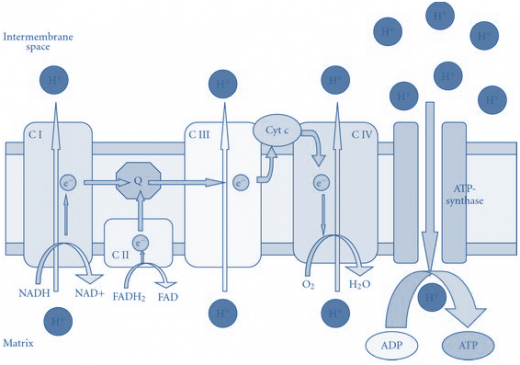Search Your Topic
Non-shivering thermogenesis : uncoupling of oxidative phosphorylation
Which of the following occurs in non-shivering thermogenesis?
A) Glucose is oxidized to lactate
B) Fatty acids uncouple oxidative phosphorylation
C) ATP is spent on heat production
D) Glycogen is excessively degraded
E) Fatty acids are excessively oxidized
The correct answer is C- Fatty acids uncouple oxidative phosphorylation
Basic Concept
The reduction of molecular oxygen to water yields a large amount of free energy that can be used to generate ATP. Oxidative phosphorylation is the process in which ATP is formed as a result of the transfer of electrons from NADH or FADH2 to O2 by a series of electron carriers (figure-1). This process, which takes place in mitochondria, is the major source of ATP in aerobic organisms.

Figure-1-Flow of electrons in the electron transport chain and ATP synthase complex. The flow of electrons from NADH or FADH2 to O2 through protein complexes located in the mitochondrial inner membrane leads to the pumping of protons out of the mitochondrial matrix. The resulting uneven distribution of protons generates a pH gradient and a transmembrane electrical potential that creates a proton-motive force. ATP is synthesized when protons flow back to the mitochondrial matrix through an enzyme complex. In other words, the electron-motive force is converted into a proton-motive force and, finally, the proton-motive force is converted into phosphoryl transfer potential.
Thus, the oxidative phosphorylation or in other words, oxidation of fuels and the phosphorylation of ADP are coupled processes.
Uncouplers of oxidative phosphorylation
This tight coupling of electron transport and phosphorylation in mitochondria can be disrupted (uncoupled) by
- 2,4- Dinitrophenol,
- 2,4 dinitrocresol
- CCCP( chloro carbonyl cyanide phenyl hydrazone)
- FCCP
- Valinomycin
- High dose of Aspirin
- The antibiotic Oligomycin completely blocks oxidation and phosphorylation by blocking the flow of protons through ATP synthase complex.
These substances carry protons across the inner mitochondrial membrane. In the presence of these uncouplers, electron transport from NADH to O2 proceeds in a normal fashion, but ATP is not formed by mitochondrial ATP synthase because of the proton-motive force across the inner mitochondrial membrane is dissipated. This loss of respiratory control leads to increased oxygen consumption and oxidation of NADH. Indeed, in the accidental ingestion of uncouplers, large amounts of metabolic fuels are consumed, but no energy is stored as ATP. Rather, energy is released as heat.
Physiological uncouplers
1) Long-chain fatty acids
2) Thyroxin
3) Brown Adipose tissue-Thermogenin (or the uncoupling protein) is a physiological uncoupler found in brown adipose tissue that functions to generate body heat, particularly for the newborn and during hibernation in animals
4) Calcium ions.
The regulated uncoupling of oxidative phosphorylation is a biologically useful means of generating heat. The uncoupling of oxidative phosphorylation is a means of generating heat to maintain body temperature in hibernating animals, in some newborn animals (including human beings), and in mammals adapted to cold. Brown adipose tissue, which is very rich in mitochondria (often referred to as brown fat mitochondria), is specialized for this process of non-shivering thermogenesis. The inner mitochondrial membrane of these mitochondria contains a large amount of uncoupling protein (UCP), here UCP-1, or Thermogenin, a dimer of 33-kd subunits that resembles ATP-ADP translocase. UCP-1 forms a pathway for the flow of protons from the cytosol to the matrix. In essence, UCP-1 generates heat by short-circuiting the mitochondrial proton battery. This UCP-1 channel is activated by fatty acids (as in the given case) – Figure-2.

Figure-2- Process of uncoupling of oxidative phosphorylation in the Brown adipose tissue.
Thus the most appropriate answer in the given situation is – uncoupling of oxidative phosphorylation by fatty acids.
As regards other options
A) Glucose is oxidized to lactate- under anaerobic conditions or in the cells lacking mitochondria. The released energy is captured as 2 mols of ATP; the surplus energy is released as heat to maintain body temperature.
C) ATP is never spent on heat production
D) Glycogen is not excessively degraded in non-shivering thermogenesis
E) Fatty acids are not excessively oxidized to yield extra energy as heat.
The manner in which biologic oxidative processes allow the free energy resulting from the oxidation of foodstuffs to become available and to be captured is stepwise, efficient, and controlled—rather than explosive, inefficient, and uncontrolled, as in many non-biologic processes. The remaining free energy that is not captured as high-energy phosphate is liberated as heat. This need not be considered “wasted,” since it ensures that the respiratory system as a whole is sufficiently exergonic, allowing continuous unidirectional flow and constant provision of ATP. It also contributes to the maintenance of body temperature.
